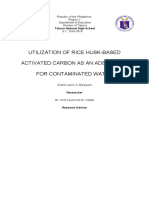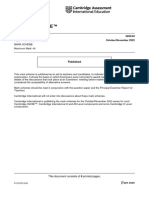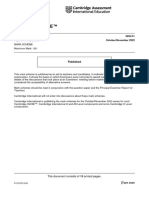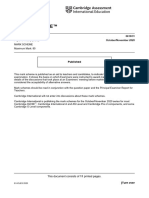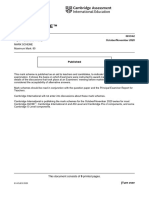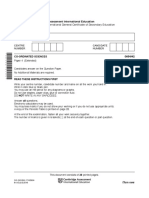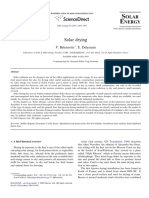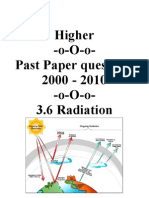Number 4 (0654 - w22 - Ms - 42)
Number 4 (0654 - w22 - Ms - 42)
Uploaded by
Muhammad Luthfansyah PrabowoCopyright:
Available Formats
Number 4 (0654 - w22 - Ms - 42)
Number 4 (0654 - w22 - Ms - 42)
Uploaded by
Muhammad Luthfansyah PrabowoOriginal Title
Copyright
Available Formats
Share this document
Did you find this document useful?
Is this content inappropriate?
Copyright:
Available Formats
Number 4 (0654 - w22 - Ms - 42)
Number 4 (0654 - w22 - Ms - 42)
Uploaded by
Muhammad Luthfansyah PrabowoCopyright:
Available Formats
Cambridge IGCSE™
CO-ORDINATED SCIENCES 0654/42
Paper 4 Theory October/November 2022
MARK SCHEME
Maximum Mark: 120
Published
This mark scheme is published as an aid to teachers and candidates, to indicate the requirements of the
examination. It shows the basis on which Examiners were instructed to award marks. It does not indicate the
details of the discussions that took place at an Examiners’ meeting before marking began, which would have
considered the acceptability of alternative answers.
Mark schemes should be read in conjunction with the question paper and the Principal Examiner Report for
Teachers.
Cambridge International will not enter into discussions about these mark schemes.
Cambridge International is publishing the mark schemes for the October/November 2022 series for most
Cambridge IGCSE™, Cambridge International A and AS Level components and some Cambridge O Level
components.
This document consists of 13 printed pages.
© UCLES 2022 [Turn over
0654/42 Cambridge IGCSE – Mark Scheme October/November 2022
PUBLISHED
Generic Marking Principles
These general marking principles must be applied by all examiners when marking candidate answers. They should be applied alongside the
specific content of the mark scheme or generic level descriptors for a question. Each question paper and mark scheme will also comply with these
marking principles.
GENERIC MARKING PRINCIPLE 1:
Marks must be awarded in line with:
• the specific content of the mark scheme or the generic level descriptors for the question
• the specific skills defined in the mark scheme or in the generic level descriptors for the question
• the standard of response required by a candidate as exemplified by the standardisation scripts.
GENERIC MARKING PRINCIPLE 2:
Marks awarded are always whole marks (not half marks, or other fractions).
GENERIC MARKING PRINCIPLE 3:
Marks must be awarded positively:
• marks are awarded for correct/valid answers, as defined in the mark scheme. However, credit is given for valid answers which go beyond the
scope of the syllabus and mark scheme, referring to your Team Leader as appropriate
• marks are awarded when candidates clearly demonstrate what they know and can do
• marks are not deducted for errors
• marks are not deducted for omissions
• answers should only be judged on the quality of spelling, punctuation and grammar when these features are specifically assessed by the
question as indicated by the mark scheme. The meaning, however, should be unambiguous.
GENERIC MARKING PRINCIPLE 4:
Rules must be applied consistently, e.g. in situations where candidates have not followed instructions or in the application of generic level
descriptors.
© UCLES 2022 Page 2 of 13
0654/42 Cambridge IGCSE – Mark Scheme October/November 2022
PUBLISHED
GENERIC MARKING PRINCIPLE 5:
Marks should be awarded using the full range of marks defined in the mark scheme for the question (however; the use of the full mark range may
be limited according to the quality of the candidate responses seen).
GENERIC MARKING PRINCIPLE 6:
Marks awarded are based solely on the requirements as defined in the mark scheme. Marks should not be awarded with grade thresholds or
grade descriptors in mind.
© UCLES 2022 Page 3 of 13
0654/42 Cambridge IGCSE – Mark Scheme October/November 2022
PUBLISHED
Science-Specific Marking Principles
1 Examiners should consider the context and scientific use of any keywords when awarding marks. Although keywords may be present, marks
should not be awarded if the keywords are used incorrectly.
2 The examiner should not choose between contradictory statements given in the same question part, and credit should not be awarded for any
correct statement that is contradicted within the same question part. Wrong science that is irrelevant to the question should be ignored.
3 Although spellings do not have to be correct, spellings of syllabus terms must allow for clear and unambiguous separation from other syllabus
terms with which they may be confused (e.g. ethane / ethene, glucagon / glycogen, refraction / reflection).
4 The error carried forward (ecf) principle should be applied, where appropriate. If an incorrect answer is subsequently used in a scientifically
correct way, the candidate should be awarded these subsequent marking points. Further guidance will be included in the mark scheme where
necessary and any exceptions to this general principle will be noted.
5 ‘List rule’ guidance
For questions that require n responses (e.g. State two reasons …):
• The response should be read as continuous prose, even when numbered answer spaces are provided.
• Any response marked ignore in the mark scheme should not count towards n.
• Incorrect responses should not be awarded credit but will still count towards n.
• Read the entire response to check for any responses that contradict those that would otherwise be credited. Credit should not be
awarded for any responses that are contradicted within the rest of the response. Where two responses contradict one another, this should
be treated as a single incorrect response.
• Non-contradictory responses after the first n responses may be ignored even if they include incorrect science.
© UCLES 2022 Page 4 of 13
0654/42 Cambridge IGCSE – Mark Scheme October/November 2022
PUBLISHED
6 Calculation specific guidance
Correct answers to calculations should be given full credit even if there is no working or incorrect working, unless the question states ‘show
your working’.
For questions in which the number of significant figures required is not stated, credit should be awarded for correct answers when rounded by
the examiner to the number of significant figures given in the mark scheme. This may not apply to measured values.
For answers given in standard form (e.g. a ´ 10n) in which the convention of restricting the value of the coefficient (a) to a value between 1 and
10 is not followed, credit may still be awarded if the answer can be converted to the answer given in the mark scheme.
Unless a separate mark is given for a unit, a missing or incorrect unit will normally mean that the final calculation mark is not awarded.
Exceptions to this general principle will be noted in the mark scheme.
7 Guidance for chemical equations
Multiples / fractions of coefficients used in chemical equations are acceptable unless stated otherwise in the mark scheme.
State symbols given in an equation should be ignored unless asked for in the question or stated otherwise in the mark scheme.
© UCLES 2022 Page 5 of 13
0654/42 Cambridge IGCSE – Mark Scheme October/November 2022
PUBLISHED
Question Answer Marks
1(a)(i) (difference =) 3.2–2.2 or 1.0 ; 2
((difference / 3.2) 100) = 31 (%) ;
1(a)(ii) any three from: 3
discovery of routes of transmission ;
(increased) use of (named) barrier contraception / abstinence ;
screening of blood transfusions ;
ref to reduced drug use / use of clean needles ;
monitoring/testing/screening, (of HIV) ;
ref to education / awareness ;
any valid point ;
1(b)(i) phagocytosis ; 2
antibody production ;
1(b)(ii) any two from: 2
red blood cells ;
platelets ;
plasma ;
1(c) placenta ; 1
Question Answer Marks
2(a)(i) (element C) has 3 electrons in the outer shell ; 1
2(a)(ii) E; 1
2(a)(iii) 2.8.5 ; 1
2(a)(iv) D; 1
2(a)(v) (Element A) has a fu ll outer shell ; 1
© UCLES 2022 Page 6 of 13
0654/42 Cambridge IGCSE – Mark Scheme October/November 2022
PUBLISHED
Question Answer Marks
2(a)(vi) 2
B D
;;
2(a)(vii) regular / alternating, arrangement ; 2
of positive and negative ions ;
2(b) 2
relative charge relative mass
proton +1 1
neutron 0 / no charge / neutral ; 1;
Question Answer Marks
3(a)(i) constant speed ; 3
stationary ;
use of data to identify change at 50 s or 200 m ;
3(a)(ii) (v =) 200 / 50 or 80 / 20 = (4 m / s) ; 1
3(a)(iii) (KE =) ½ mv2 or ½ 100 42 ; 2
(KE =) 800 (J) ;
3(b) (M =) f d or 600 40 or 24000 (Ncm) ; 3
(F =) 24000 / 100 ;
(F =) 240 (N) ;
© UCLES 2022 Page 7 of 13
0654/42 Cambridge IGCSE – Mark Scheme October/November 2022
PUBLISHED
Question Answer Marks
4(a)(i) B; 1
4(a)(ii) variation / AW ; 4
die ;
alleles ;
resistance ;
4(b) evolution linked to: 2
increases suitability to the environment ;
is a change of adaptive features ;
4(c)(i) change in the gene / chromosome ; 1
4(c)(ii) ionising ; 1
Question Answer Marks
5(a) (distance travelled by substance =) 4.5 ; 2
(Rf = 4.5 5.0 =) 0.90 ;
5(b) (distance moved by D) = Rf distance moved by solvent or 0.56 5.0 ; 2
(distance moved by D) = 2.8 (cm) ;
5(c) A; 1
5(d) V and Y; 2
idea that pure substances, have a specific melting point / do not melt over a range (of temperatures) / ORA ;
5(e) moles = 4.8 ÷ 192 or 0.025 ; 3
conversion of cm³ to dm³ / 250 cm³ = 0.25 dm³ ;
concentration = 0.025 ÷ 0.25 = 0.10 (mol / dm³) ;
© UCLES 2022 Page 8 of 13
0654/42 Cambridge IGCSE – Mark Scheme October/November 2022
PUBLISHED
Question Answer Marks
6(a)(i) (I =) 0.08 A ; 3
(R =) V / I or 2000 / 0.08 ;
(R =) 25000 (Ω) ;
6(a)(ii) use of 1 / RT =1 / R + 1 / R ; 2
(R =) 50000 (Ω) ;
6(a)(iii) (resistance) doubles ; 1
6(b)(i) rarefaction and compressions ; 1
6(b)(ii) (d =) v t or 167.5 ; 2
(d =) 120 (m) ;
6(c) black will show the higher temperature / ORA ; 2
black emits more (infrared) radiation than white ;
Question Answer Marks
7(a) offspring circled ; 2
time circled ;
7(b)(i) C; 1
7(b)(ii) 0.75 (kg) ; 1
7(c)(i) surface producers block light ; 2
so no photosynthesis ;
7(c)(ii) ref to decomposition of producers / AW ; 3
ref to (aerobic) respiration of decomposers ;
reduction in (dissolved) oxygen ;
© UCLES 2022 Page 9 of 13
0654/42 Cambridge IGCSE – Mark Scheme October/November 2022
PUBLISHED
Question Answer Marks
8(a)(i) any pH below 7 ; 1
8(a)(ii) (red litmus paper turns) blue ; 1
8(a)(iii) H2SO4 + 2NaOH → Na2SO4 + 2H2O ; 2
8(b) (an acid is) a proton donor / owtte ; 1
88(c) (relative molecular mass of H2SO4 =)98 ; 2
(concentration = 0.2 98 =) 19.6 (g / dm3) ;
8(d)(i) 2SO2 + O2 ⇌ 2SO3 ; 2
8(d)(ii) temperature 450 °C ; 2
vanadium(V) oxide / V2O5 / catalyst ;
Question Answer Marks
9(a) (advantage) 2
high energy density / fast start up of power stations / abundant / easily available / easy to transport or store / reliable / easily
combustible / AVP ;
(disadvantage)
releases CO2 / causes global warming / climate change / finite or non-renewable resource / releases SO2 / causes acid
rain / pollution from particulates / AVP ;
9(b)(i) (forces) stronger in liquid / ORA ; 3
(distance) closer in liquid / ORA ;
(motion) molecules are freer to move in gas / ORA ;
9(b)(ii) increases 2
decreases ;
decreases
increases ;
© UCLES 2022 Page 10 of 13
0654/42 Cambridge IGCSE – Mark Scheme October/November 2022
PUBLISHED
Question Answer Marks
9(c)(i) use of Vp / Vs = Np / Ns ; 2
2400 ;
9(c)(ii) reduces current ; 2
reduces, power or energy losses / less heat generated ;
Question Answer Marks
10(a)(i) B; 4
B;
A;
D;
10(a)(ii) circle drawn round the vascular bundle ; 1
10(b)(i) amino acids ; 2
sucrose ;
10(b)(ii) sink 2
source
sink
;;
1 correct = 0
2 correct = 1
3 correct = 2
10(c)(i) CO2 ; 1
10(c)(ii) any two from: 2
large surface area ;
thin (surface) ;
good blood supply ;
good ventilation with air ;
© UCLES 2022 Page 11 of 13
0654/42 Cambridge IGCSE – Mark Scheme October/November 2022
PUBLISHED
Question Answer Marks
11(a) 1
11(b) any two from: 2
same general formula / have formula C2H2 ;
similar chemical properties ;
contain (at least one) double bond ;
11(c) 1
11(d) 2
mark for single bond between carbon atoms ;
mark for rest of structure correct ;
11(e) addition polymerisation requires one monomer / condensation 2
polymerisation requires two monomers ;
addition polymerisation produces a polymer only / condensation
polymerisation produces a polymer molecule and a small
molecule ;
© UCLES 2022 Page 12 of 13
0654/42 Cambridge IGCSE – Mark Scheme October/November 2022
PUBLISHED
Question Answer Marks
12(a)(i) α-particles cannot penetrate the lead ; 2
(only recording) background radiation ;
12(a)(ii) gamma is more penetrating (than alpha) ; 1
12(b)(i) 2
correct angle of reflection ;
correct arrow direction ;
12(b)(ii) (transfers energy through) oscillations / vibrations ; 2
oscillations are perpendicular to direction of energy transfer ;
12(b)(iii) (λ =) v / f or 3.0 108/5.0 1014 ; 2
(λ =) 6.0 10-7 (m) ;
© UCLES 2022 Page 13 of 13
You might also like
- GRE Chemistry: Inorganic Chemistry Review for GRE Chemistry Subject TestFrom EverandGRE Chemistry: Inorganic Chemistry Review for GRE Chemistry Subject TestNo ratings yet
- Diagnóstico Por Imagem - ThrallDocument764 pagesDiagnóstico Por Imagem - ThrallMariana de Queiroz Sampaio100% (1)
- Utilization of Rice Husk Based Activated Carbon As An Adsorbent For Contaminated WaterDocument7 pagesUtilization of Rice Husk Based Activated Carbon As An Adsorbent For Contaminated WaterLance BaraquielNo ratings yet
- Cambridge IGCSE ™: Co-Ordinated Sciences 0654/42 October/November 2022Document13 pagesCambridge IGCSE ™: Co-Ordinated Sciences 0654/42 October/November 2022xuanquynhle03.95No ratings yet
- 0610 m22 Ms 32 PDFDocument11 pages0610 m22 Ms 32 PDFsolihinNo ratings yet
- Cambridge IGCSE ™: Combined Science 0653/42 October/November 2022Document12 pagesCambridge IGCSE ™: Combined Science 0653/42 October/November 2022kavya pNo ratings yet
- June 2022 Mark Scheme Paper 41Document12 pagesJune 2022 Mark Scheme Paper 41Hằng DiệuNo ratings yet
- Cambridge IGCSE ™: Physical Science 0652/62 October/November 2022Document8 pagesCambridge IGCSE ™: Physical Science 0652/62 October/November 2022socil27374No ratings yet
- 0610 m22 Ms 42 PDFDocument12 pages0610 m22 Ms 42 PDFdavin tejaNo ratings yet
- Cambridge IGCSE™: Physical Science 0652/31 October/November 2021Document9 pagesCambridge IGCSE™: Physical Science 0652/31 October/November 2021lewis100% (1)
- Cambridge IGCSE™: Biology 0610/42 February/March 2022Document12 pagesCambridge IGCSE™: Biology 0610/42 February/March 2022bali yunNo ratings yet
- Cambridge IGCSE™: Combined Science 0653/42 May/June 2022Document12 pagesCambridge IGCSE™: Combined Science 0653/42 May/June 2022Thelma MusvotaNo ratings yet
- Cambridge IGCSE™: Combined Science 0653/42 May/June 2020Document11 pagesCambridge IGCSE™: Combined Science 0653/42 May/June 2020septinNo ratings yet
- Cambridge IGCSE™: Combined Science 0653/32 May/June 2022Document10 pagesCambridge IGCSE™: Combined Science 0653/32 May/June 2022Thelma MusvotaNo ratings yet
- Cambridge IGCSE™: Combined Science 0653/31 May/June 2022Document11 pagesCambridge IGCSE™: Combined Science 0653/31 May/June 2022Thelma MusvotaNo ratings yet
- Cambridge IGCSE™: Biology 0610/62 May/June 2022Document8 pagesCambridge IGCSE™: Biology 0610/62 May/June 2022walsha khanNo ratings yet
- November 2022 Mark Scheme Paper 31Document10 pagesNovember 2022 Mark Scheme Paper 31mokgethitshidi218No ratings yet
- Cambridge IGCSE ™: Co-Ordinated Sciences 0654/31 October/November 2022Document13 pagesCambridge IGCSE ™: Co-Ordinated Sciences 0654/31 October/November 2022wangfeifei620No ratings yet
- Ans Paper 6Document7 pagesAns Paper 6suhaankochhar2008No ratings yet
- Cambridge IGCSE ™: Biology 0610/63 October/November 2022Document8 pagesCambridge IGCSE ™: Biology 0610/63 October/November 2022ramloghun veerNo ratings yet
- 0610 Paper 4 2022-24 MsDocument225 pages0610 Paper 4 2022-24 MsfocusedstudyingurlsNo ratings yet
- Cambridge IGCSE™: Combined Science 0653/41 October/November 2020Document10 pagesCambridge IGCSE™: Combined Science 0653/41 October/November 2020Omar ElsayedNo ratings yet
- June 2022 Mark Scheme Paper 51Document9 pagesJune 2022 Mark Scheme Paper 51adannaajaegboNo ratings yet
- June 2022 Mark Scheme Paper 21Document12 pagesJune 2022 Mark Scheme Paper 21joenmupindu550No ratings yet
- Cambridge IGCSE ™: Biology 0610/62 October/November 2022Document10 pagesCambridge IGCSE ™: Biology 0610/62 October/November 2022vanshrajsinh9No ratings yet
- Cambridge IGCSE ™: Biology 0610/62 October/November 2022Document10 pagesCambridge IGCSE ™: Biology 0610/62 October/November 2022ramloghun veerNo ratings yet
- Cambridge O Level: Combined Science 5129/22 May/June 2022Document12 pagesCambridge O Level: Combined Science 5129/22 May/June 2022Kelvin SamatahNo ratings yet
- Cambridge IGCSE™: Combined Science 0653/42 March 2020Document10 pagesCambridge IGCSE™: Combined Science 0653/42 March 202058.Nguyễn Thị Diệu LinhNo ratings yet
- Cambridge IGCSE™: Co-Ordinated Scienes 0654/42 October/November 2020Document13 pagesCambridge IGCSE™: Co-Ordinated Scienes 0654/42 October/November 2020Khoa DangNo ratings yet
- Cambridge IGCSE™: Combined Science 0653/62 February/March 2022Document8 pagesCambridge IGCSE™: Combined Science 0653/62 February/March 2022jesslynaureliaNo ratings yet
- Cambridge IGCSE ™: Co-Ordinated Sciences 0654/41Document15 pagesCambridge IGCSE ™: Co-Ordinated Sciences 0654/41Khoa DangNo ratings yet
- Paper 32 MsDocument10 pagesPaper 32 Msdhritikapadia747No ratings yet
- Cambridge IGCSE™: Chemistry 0620/43Document11 pagesCambridge IGCSE™: Chemistry 0620/43krishaNo ratings yet
- Cambridge O Level: Physics 5054/42Document9 pagesCambridge O Level: Physics 5054/42Rithika HimathNo ratings yet
- Cambridge IGCSE™ (9-1) : Co-Ordinated Sciences (9-1) 0973/62 May/June 2022Document10 pagesCambridge IGCSE™ (9-1) : Co-Ordinated Sciences (9-1) 0973/62 May/June 2022t.dyakivNo ratings yet
- Cambridge IGCSE ™: BiologyDocument12 pagesCambridge IGCSE ™: BiologyTom TommmaNo ratings yet
- Cambridge IGCSE™: Co-Ordinated SciencesDocument14 pagesCambridge IGCSE™: Co-Ordinated SciencesGun MatasNo ratings yet
- Cambridge IGCSE™: Environmental Management 0680/11 May/June 2022Document15 pagesCambridge IGCSE™: Environmental Management 0680/11 May/June 2022chrismpod123No ratings yet
- Cambridge IGCSE ™: BiologyDocument12 pagesCambridge IGCSE ™: BiologyAhmed TarekNo ratings yet
- Cambridge IGCSE™: Co-Ordinated Sciences 0654/42 May/June 2020Document13 pagesCambridge IGCSE™: Co-Ordinated Sciences 0654/42 May/June 2020Man Hol KwanNo ratings yet
- Cambridge IGCSE ™: Physics 0625/52 October/November 2022Document9 pagesCambridge IGCSE ™: Physics 0625/52 October/November 2022Ar Ar ViNo ratings yet
- Cambridge IGCSE ™: Biology 0610/42 October/November 2022Document15 pagesCambridge IGCSE ™: Biology 0610/42 October/November 2022dudidam24No ratings yet
- Cambridge IGCSE ™: Combined Science 0653/42Document12 pagesCambridge IGCSE ™: Combined Science 0653/42haleemafaizann2008No ratings yet
- Cambridge International AS & A Level: Biology 9700/34 May/June 2022Document8 pagesCambridge International AS & A Level: Biology 9700/34 May/June 2022mariakhan.educationNo ratings yet
- Cambridge IGCSE ™: Combined ScienceDocument11 pagesCambridge IGCSE ™: Combined ScienceAhmed Jomaa Salem0% (1)
- Cambridge IGCSE™: Combined Science 0653/42 March 2020Document10 pagesCambridge IGCSE™: Combined Science 0653/42 March 2020Hin Wa LeungNo ratings yet
- Cambridge IGCSE ™: Chemistry 0620/43Document11 pagesCambridge IGCSE ™: Chemistry 0620/43Shashwat VignaradjNo ratings yet
- Cambridge IGCSE™: Biology 0610/31 October/November 2020Document11 pagesCambridge IGCSE™: Biology 0610/31 October/November 2020bocciamercedesNo ratings yet
- Cambridge IGCSE™: Combined Science 5129/21 October/November 2020Document11 pagesCambridge IGCSE™: Combined Science 5129/21 October/November 2020togeg44760No ratings yet
- Biology IGCSE Paper 3 0970 MSDocument12 pagesBiology IGCSE Paper 3 0970 MSgideon.cavidaNo ratings yet
- Cambridge IGCSE™: Combined Science 0653/52 March 2020Document8 pagesCambridge IGCSE™: Combined Science 0653/52 March 2020Hin Wa LeungNo ratings yet
- Cambridge IGCSE ™: Biology 0610/42 October/November 2022Document15 pagesCambridge IGCSE ™: Biology 0610/42 October/November 2022dharshini_perumalNo ratings yet
- November 2020 Mark Scheme Paper 51Document8 pagesNovember 2020 Mark Scheme Paper 51SULTAN SURGANo ratings yet
- Cambridge IGCSE™: Physical Education 0413/11 May/June 2022Document21 pagesCambridge IGCSE™: Physical Education 0413/11 May/June 2022tinayekawadzaNo ratings yet
- Cambridge O Level: Chemistry 5070/32 October/November 2022Document7 pagesCambridge O Level: Chemistry 5070/32 October/November 2022Ankit MistryNo ratings yet
- Cambridge IGCSE™: Co-Ordinated SciencesDocument14 pagesCambridge IGCSE™: Co-Ordinated SciencesInga NaranbatNo ratings yet
- Cambridge IGCSE™: Combined Science 0653/61 May/June 2020Document7 pagesCambridge IGCSE™: Combined Science 0653/61 May/June 2020Hin Wa LeungNo ratings yet
- Cambridge IGCSE™: Combined Science 0653/42 October/November 2020Document9 pagesCambridge IGCSE™: Combined Science 0653/42 October/November 2020keyzainbNo ratings yet
- Cambridge O Level: Chemistry 5070/41 May/June 2022Document10 pagesCambridge O Level: Chemistry 5070/41 May/June 2022Saeed RehmanNo ratings yet
- Cambridge O Level: Chemistry 5070/21 October/November 2022Document12 pagesCambridge O Level: Chemistry 5070/21 October/November 2022jamshedNo ratings yet
- Cambridge O Level: Chemistry 5070/21 October/November 2022Document12 pagesCambridge O Level: Chemistry 5070/21 October/November 2022AnemarrNo ratings yet
- Cambridge IGCSE™: Chemistry 0620/31Document10 pagesCambridge IGCSE™: Chemistry 0620/31wokoba7588No ratings yet
- Grade 8 - 1st QuizDocument2 pagesGrade 8 - 1st QuizMuhammad Luthfansyah PrabowoNo ratings yet
- ElectrolysisDocument19 pagesElectrolysisMuhammad Luthfansyah PrabowoNo ratings yet
- Number 2 (0654 - s20 - Ms - 43)Document13 pagesNumber 2 (0654 - s20 - Ms - 43)Muhammad Luthfansyah PrabowoNo ratings yet
- Cambridge IGCSE: Co-Ordinated Sciences 0654/43Document28 pagesCambridge IGCSE: Co-Ordinated Sciences 0654/43Muhammad Luthfansyah PrabowoNo ratings yet
- Cambridge IGCSE: Co-Ordinated Sciences 0654/42Document28 pagesCambridge IGCSE: Co-Ordinated Sciences 0654/42Muhammad Luthfansyah PrabowoNo ratings yet
- Cambridge International General Certificate of Secondary EducationDocument28 pagesCambridge International General Certificate of Secondary EducationMuhammad Luthfansyah PrabowoNo ratings yet
- Number 1 (0654 - s21 - Ms - 42)Document13 pagesNumber 1 (0654 - s21 - Ms - 42)Muhammad Luthfansyah PrabowoNo ratings yet
- 3 6 1-Circular-MotionDocument78 pages3 6 1-Circular-Motionkrishkhatri1501No ratings yet
- CJR Bahasa InggrisDocument6 pagesCJR Bahasa InggrisNICOLAUS FIDAL DIAZ MANURUNGNo ratings yet
- Industrial AreaDocument15 pagesIndustrial AreaFaria HossainNo ratings yet
- PP UNIT 4 PVD CVD EditedDocument51 pagesPP UNIT 4 PVD CVD EditedRAHUL RAJNo ratings yet
- Topic s1.3hlDocument18 pagesTopic s1.3hlbobadeakshat123No ratings yet
- Book 47 Refinery Area Classifications ReDocument24 pagesBook 47 Refinery Area Classifications ReMohammadShamimNo ratings yet
- Lecture 15 SolarDocument56 pagesLecture 15 SolarAshraf Nabil SanhouryNo ratings yet
- Introduction Tray DryerDocument2 pagesIntroduction Tray Dryerdrami9450% (2)
- Spontaneity, Entropy and Free Energy: DE Chemistry Dr. WalkerDocument50 pagesSpontaneity, Entropy and Free Energy: DE Chemistry Dr. WalkerJennette BelliotNo ratings yet
- SAM Webinars 2017: Sizing Photovoltaic Systems in SAM 2017.1.17Document15 pagesSAM Webinars 2017: Sizing Photovoltaic Systems in SAM 2017.1.17Johan MantuanoNo ratings yet
- 2017 - Andino and Borghi - Occurrence of Ctenomys AAARDocument8 pages2017 - Andino and Borghi - Occurrence of Ctenomys AAARVictor ValdiviaNo ratings yet
- Flow Separation of Axial Compressor Cascade Blades: Journal of Engineering Volume 16 September 2010 Number 3Document20 pagesFlow Separation of Axial Compressor Cascade Blades: Journal of Engineering Volume 16 September 2010 Number 3inam vfNo ratings yet
- Dry Steam Flash Steam: What Is Geothermal Energy?Document6 pagesDry Steam Flash Steam: What Is Geothermal Energy?Saurabh ChougaleNo ratings yet
- Chapter 3 - Electric Potential 3.0 Electric Potential EnergyDocument18 pagesChapter 3 - Electric Potential 3.0 Electric Potential EnergyLuqman HakimNo ratings yet
- AcetaldehydeDocument9 pagesAcetaldehydeSam ShubhamNo ratings yet
- Department of Mechanical Engineering. Mce315 Design Studies 1 Report On ExperimentDocument9 pagesDepartment of Mechanical Engineering. Mce315 Design Studies 1 Report On ExperimentBukky EmmanuelNo ratings yet
- Solar Drying: V. Belessiotis, E. DelyannisDocument27 pagesSolar Drying: V. Belessiotis, E. DelyannisHIMANSHU SHARMANo ratings yet
- EST MicroProject 69Document16 pagesEST MicroProject 69Jay Hatge100% (1)
- Epidemiology CAT Results For Aug-Intake 2021-1Document10 pagesEpidemiology CAT Results For Aug-Intake 2021-1kuchie ranksNo ratings yet
- 3.6.2 Radiation 00-10Document16 pages3.6.2 Radiation 00-10Murray PhysicsNo ratings yet
- CHAPTER ONE-IntrodctionDocument39 pagesCHAPTER ONE-IntrodctionAnbesaw MitikuNo ratings yet
- Final Suratgarh Report PDFDocument39 pagesFinal Suratgarh Report PDFpriyaNo ratings yet
- Impact of Recycled Aggregate Properties On Concrete PerformanceDocument13 pagesImpact of Recycled Aggregate Properties On Concrete PerformanceIvan NikolaevNo ratings yet
- Foam EOR As An Optimization Technique For Gas EOR - A Comprehensive Review of Laboratory and Field ImplementationsDocument52 pagesFoam EOR As An Optimization Technique For Gas EOR - A Comprehensive Review of Laboratory and Field ImplementationsAshrafNo ratings yet
- Relative Dating vs. Absolute Dating: What's The Difference?Document5 pagesRelative Dating vs. Absolute Dating: What's The Difference?Alvin Mas MandapatNo ratings yet
- Giant Predators of The Ancient Seas by Ginny Johnston and Judy CutchinsDocument10 pagesGiant Predators of The Ancient Seas by Ginny Johnston and Judy CutchinsPineapple Press, Inc.No ratings yet
- Applied Physics - P. K. PalanisamyDocument63 pagesApplied Physics - P. K. PalanisamyPhanitha veeranki0% (1)
- Schedule Oral PIT HAGI 2020 - 14102020-Rev#3Document1 pageSchedule Oral PIT HAGI 2020 - 14102020-Rev#3Restu Ari WibowoNo ratings yet


